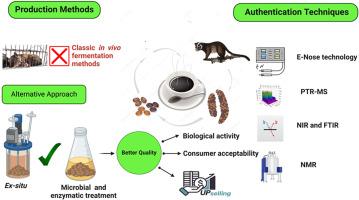Advancements in civet coffee production and analytical techniques: From aroma profiling to market dynamics and ethical considerations
IF 15.1
1区 农林科学
Q1 FOOD SCIENCE & TECHNOLOGY
引用次数: 0
Abstract
Background
Civet coffee is produced from coffee beans that have been consumed and excreted by civets. However, its production raises several ethical concerns. The increasing cases of adulteration create significant challenges in verifying the authenticity of civet coffee. Currently, there is no comprehensive review addressing alternative and sustainable production methods for civet coffee. This manuscript aims to fill this knowledge gap and serve as a reference for improving civet coffee fermentation.
Scope and approach
This paper explores innovative techniques for producing civet coffee while considering ethical and sustainability issues. It examines market trends and authentication methods, focusing on technologies such as electronic nose (E-Nose) technology, proton-transfer-reaction time-of-flight mass spectrometry (PTR-ToF-MS), UV–visible spectroscopy, infrared spectroscopy (NIR and FTIR), and nuclear magnetic resonance (NMR). Additionally, it discusses the health-promoting effects of civet coffee.
Key findings and conclusions
Alternative methods to the in vivo fermentation of civet coffee, using isolated bacteria (i.e., Bacillus subtilis), yeast, and fungi from the civet's gastrointestinal tract or excreta in glass jars or bioreactors, have significantly enhanced the fermentation process. These methods resulted in improved and consistent coffee quality, flavor, and nutritional value. Technologies like e-nose PTR-ToF-MS effectively distinguish civet coffee from non-civet variants through aroma and marker profiling. Additionally, UV–Vis, NIR, FTIR, NMR, GC/MS, and GC/FID, combined with chemometrics, have demonstrated significant efficacy in distinguishing farmed and wild types of civets. Despite its high price, civet coffee continues to see a growing global demand as consumers increasingly prioritize quality, health benefits and authenticity. Innovative analytical techniques are essential for maintaining the integrity of civet coffee. However, addressing animal welfare concerns in civet coffee production is crucial to meet the expectations of ethically and sustainability-conscious consumers.

果子狸咖啡生产和分析技术的进步:从香气分析到市场动态和道德考量
背景果子狸咖啡由果子狸食用并排泄的咖啡豆制成。然而,其生产引发了一些道德问题。越来越多的掺假案例给果子狸咖啡的真实性验证带来了巨大挑战。目前,还没有关于果子狸咖啡替代性和可持续生产方法的全面综述。本文旨在填补这一知识空白,为改进果子狸咖啡发酵提供参考。它研究了市场趋势和鉴定方法,重点关注电子鼻(E-Nose)技术、质子转移反应飞行时间质谱(PTR-ToF-MS)、紫外可见光谱、红外光谱(NIR 和 FTIR)以及核磁共振(NMR)等技术。主要发现和结论果子狸咖啡体内发酵的替代方法是使用从果子狸胃肠道或排泄物中分离出来的细菌(即枯草芽孢杆菌)、酵母和真菌在玻璃罐或生物反应器中进行发酵,这些方法大大提高了发酵过程。这些方法使咖啡的质量、风味和营养价值得到了改善和稳定。电子鼻 PTR-ToF-MS 等技术可通过香气和标记分析有效区分果子狸咖啡和非果子狸咖啡。此外,UV-Vis、NIR、FTIR、NMR、GC/MS 和 GC/FID 与化学计量学相结合,在区分果子狸养殖和野生类型方面也显示出显著功效。尽管果子狸咖啡价格昂贵,但随着消费者对其品质、健康益处和真实性的日益重视,全球对果子狸咖啡的需求仍在不断增长。创新的分析技术对于保持果子狸咖啡的完整性至关重要。然而,要满足注重道德和可持续发展的消费者的期望,解决果子狸咖啡生产中的动物福利问题至关重要。
本文章由计算机程序翻译,如有差异,请以英文原文为准。
求助全文
约1分钟内获得全文
求助全文
来源期刊

Trends in Food Science & Technology
工程技术-食品科技
CiteScore
32.50
自引率
2.60%
发文量
322
审稿时长
37 days
期刊介绍:
Trends in Food Science & Technology is a prestigious international journal that specializes in peer-reviewed articles covering the latest advancements in technology, food science, and human nutrition. It serves as a bridge between specialized primary journals and general trade magazines, providing readable and scientifically rigorous reviews and commentaries on current research developments and their potential applications in the food industry.
Unlike traditional journals, Trends in Food Science & Technology does not publish original research papers. Instead, it focuses on critical and comprehensive reviews to offer valuable insights for professionals in the field. By bringing together cutting-edge research and industry applications, this journal plays a vital role in disseminating knowledge and facilitating advancements in the food science and technology sector.
 求助内容:
求助内容: 应助结果提醒方式:
应助结果提醒方式:


